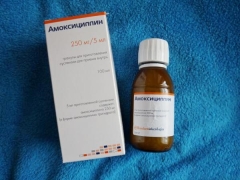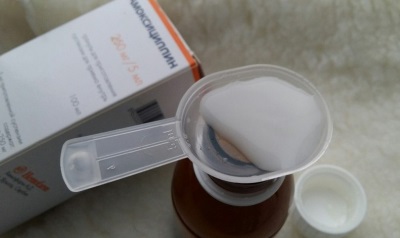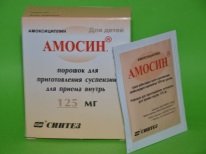Granules "Amoxicillin" for the preparation of suspensions (syrup) for children
If a child is diagnosed with a bacterial infection, the doctor prescribes the child one of the effective antibiotics with a wide spectrum of activity against microorganisms. One of these drugs can be called Amoxicillin. Especially for children, it is released in granules so that parents can prepare a sweet home suspension in the form of syrup. From what age and in what dosage do you give this medicine to a sick child?
Release form
Amoxicillin in granules it is packaged in dark glass bottles weighing 40 grams. Inside one bottle is enough white or white-yellow granules to make 100 ml of a yellowish suspension with the smell of fruit. Because of the sweet taste of this liquid, some mothers call syrup.
In the package there is a measuring spoon that helps to accurately dose the drug. Its total volume is 5 ml, but inside the spoon there is a risk by which only 2.5 ml of the suspension can be measured. In addition to this form, Amoxicillin is also produced in tablets and capsules, but in the treatment of children in the first years of life it is more convenient to use a liquid preparation.
Composition
The main component of the drug is amoxicillin trihydrate. In 5 ml of the suspension prepared from Amoxicillin granules contains 250 mg of this compound. For sweetness, the preparation contains sucrose and saccharinate sodium, and strawberry, raspberry and passionflower flavors give a pleasant scent to the medicine. Also such Amoxicillin contains sodium benzoate, sodium citrate, guar gum and simethicone.
Operating principle
Amoxicillin is included in the group of penicillin antibiotics and is a drug with a very extensive antimicrobial action. Since this medicine destroys germs, this effect is called bactericidal.
The drug affects different types of staphylococci, Escherichia coli, Salmonella, Streptococcus, as well as gonococci, Clostridium, meningococci, Chlamydia, Helicobacter, Listeria and many other bacteria. However, it is ineffective in the fight against certain microorganisms. In addition, Amoxicillin is powerless against viruses.
Indications
The drug is prescribed to children with infectious diseases caused by microbe that is sensitive to Amoxicillin.
This medicine is in demand:
- For angina, sinusitis, bronchitis, otitis, pharyngitis, or other infectious diseases of the upper respiratory tract and respiratory system.
- When bacteria infect the urogenital organs, for example, with urethritis or nephritis.
- With meningitis, peritonitis, sepsis and other dangerous infections.
- With various intestinal infections, among which dysentery, salmonellosis and leptospirosis.
- With gastrointestinal ulcer and inflammation of the gallbladder.
- With infections of soft tissues and skin.
At what age is it allowed to take?
Pediatricians allow treatment with Amoxicillin as a suspension in children since birth. However, babies under one year old should not be given such a medicine without a prescription. However, you should not treat children with Amoxicillin, without consulting with a pediatrician, and at an older age. If the child is already 5-6 years old, instead of the suspension, it is already possible to use a tablet form of the drug.
Contraindications
If a child has an allergy to penicillin or cephalosporin antibacterial drugs, you should not give him Amoxicillin.
Restrictions on taking the drug will also be:
- Pathology of the liver.
- Allergic diseases.
- Kidney disease.
- Leukemia
- Breast-feeding.
- Negative gastrointestinal reactions to antibiotic therapy in the past.
- Bleeding in history.
Any of these problems requires the doctor to prescribe Amoxicillin to the child very carefully.
Side effects
On the use of Amoxicillin, the children's body can "respond"
- Allergies.
- Dyspepsia.
- Headaches.
- Decrease in the number of blood cells.
- Increased heart rate.
- Sleep problems.
- Abnormal liver function.
In some babies, the drug provokes dysbacteriosis or candidiasis. Occasionally, Amoxicillin can cause such serious problems as seizures, enterocolitis, anaphylactic shock, and superinfection.
Instructions for use and dosage
To dilute the granules, boiled water at room temperature is required. It is poured into the vial until the label marked on the bottle is sealed with a lid and carefully shaken so that the dry matter evenly mixes with the liquid.
Next, the child is given a ready-made suspension, measuring it with a spoon, in such a single dose:
In the first two years of life | In a volume corresponding to 20 mg of amoxicillin per kilogram of baby weight |
Children from 2 to 5 years | 125 mg of active substance (this is 2.5 ml of suspension) |
Children from 5 to 10 years | 250 mg of the active ingredient, which corresponds to 5 ml of the drug (one scoop) |
Children over 10 years old | 500 mg of amoxicillin, which corresponds to 2 scoops, including 10 ml of medication |
The drug is prescribed in this dosage three times within 5-12 days. A more accurate duration of treatment is determined by the doctor considering the disease, but after the disappearance of the clinical manifestations, Amoxicillin continues to give another 2-3 days.
Overdose
If you give Amoxicillin suspension to a child in too high a dose, it will lead to vomiting and diarrhea, as well as to dehydration. Immediately after an overdose, it is recommended to rinse the stomach and give the baby a sorbent, after which it is necessary to unsolve the child with rehydration solutions. If the poisoning is severe, you should call an ambulance.
Interaction with other drugs
The drug will be absorbed and act worse if it is combined with the use of laxatives, antacids, glucosamine, or bacteriostatic antibiotics. Amoxicillin will intensify when combined with vitamin C or other antibacterial antimicrobial drugs. If you use indirect anticoagulants, their effectiveness under the influence of Amoxicillin will increase.
Terms of sale
The drug is sold in pharmacies by prescription. The average price of a bottle of granules is 90-100 rubles.
Storage conditions and shelf life
To Amoxicillin did not lose its effectiveness, it is advised to keep away from moisture and direct sunlight, and the optimal temperature range of storage is called + 15 + 25 degrees Celsius. It is important that such medication is not easily accessible to children. The shelf life of a non-opened bottle is 3 years. If a suspension has already been made from the granules, it is possible to store such liquid medicine for only 2 weeks.
Reviews
About Amoxicillin suspension there are a variety of reviews. Some mothers praise her for quick and effective action, ease of dosing, pleasant taste and low price. Others criticize for frequent side effects (for example, nausea, allergic rash or diarrhea), triple intake and short shelf life. However, in most reviews, parents say that the drug helped with angina, bronchitis or other infections. But sometimes there are cases when the medication turned out to be ineffective and the child needed to be given another antibiotic.
Analogs
To replace Amoxicillin suspension, any other medication containing the same active compound may be suitable. Among all the analogues in suspension produced Ospamox, Amosin and hikontsil.Also in the treatment of children, instead of Amoxicillin, another penicillin antibiotic can be used, for example, Ampicillin or Oxacillin.
From the following video you will learn why antibiotics are needed and when they are used. Comments on the popular children's doctor Komarovsky.

























